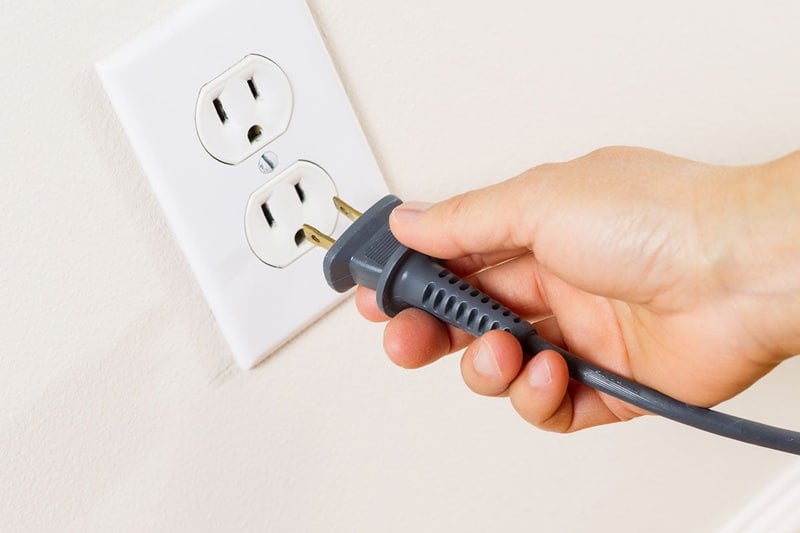Is your coffee maker blowing fuses or tripping breakers? Here’s 5 fixes you can try.
If you’re in this situation, you’re no stranger to the frustration of hearing that circuit breaker go off as soon as you plug in your appliance. What ever happened to just turning on your coffee maker and brewing delicious cups to start your morning?
Having your coffee maker constantly blow fuses is not only nerve wracking, but also dangerous, as it leaves it vulnerable to future power spikes. And yes, replacing a blown fuse is no big deal, but having to do it too often can definitely get old fast.
There are many reasons why your coffee maker might be acting this way, and some of them are not even the appliance’s fault, but rather an issue with your house’s wiring or the way you’ve been using it.
If only there was a clear and detailed list explaining the possible causes and fixes to these issues! Everything would be resolved in the blink of an eye.
Well, you’re in luck…there is.
Below, you’ll find everything you need to know about your coffee maker and its blown fuses.
Let’s get you back to drinking more coffee, and resetting fewer breakers!
Your Coffee Maker Might Be Blowing Fuses or Tripping Breakers Due To…
- A faulty outlet
- A bad power cord
- Leakage (short circuit)
- Overheating
- Overloading
You’d be surprised at how many times the problem with a troublesome coffee maker didn’t lie in the appliance itself, but in external factors that no one thought to consider because they were “too obvious”.
I’m a big believer in going from simple to complex when troubleshooting, which is why I’ve arranged the list above in that order.
#1 the Wall Outlet You Use Is Faulty
Your coffee maker might not be the problem
From time to time, the wiring within a home is not done properly or shows signs of wear and tear over time. It’s just the natural order of things. The problem is, though, that when this degradation occurs in key elements of your living space (like the wall outlets), the consequences can be dire.
If your coffee maker keeps blowing fuses or tripping breakers, the appliance itself might not be at fault.
Solution: Try a different outlet. Yes, it’s that simple.
If your problems start as soon as you plug in your coffee maker, chances are, the outlet you use is faulty. The best way to confirm or rule this factor as the culprit is to carefully unplug your coffee maker, and try connecting it to a different wall outlet in your home. Preferably in a different section of the house.
If no fuses blow and the circuit breaker is fine after trying this, you’re good to go.
Additionally, if you want a challenge, you can test the suspicious oulet to confirm that it’s bad; however, I must insist that if you do, you follow all the necessary precautions or call a technician to help you out.

#2 Your Power Cord Is Done For
Test a different cable if possible
If you tried the previous solution with no success, the next thing to test is your power cord.
Given how sturdy and durable household appliances are designed to be, you’d think the cord that feeds them power would be too, right? Well, sadly, this is not the case. In fact, damaging them is fairly easy.
All it takes is keeping your cord tangled or strongly pressed against a wall to destroy it over time. If your coffee maker works normally, but the slightest movement of the cord causes all hell to break loose, this is probably the reason why.
Solution: Replace the cord.
If you happen to have a spare one lying around somewhere in your house, you can try operating your coffee maker with it. If the problem is resolved, you’ll know for sure you had a bad cord.
Having said that, I know not everyone has spare cables lying around, so if you fall into that category, there’s nothing to worry about, you can get a new power cord for your coffee maker at any online marketplace for less than $20.

#3 Leakage
Be on the lookout for leaks
This one is very dangerous. Water and electricity don’t mix well.
Having a leaky coffee maker can be attributed to a number of reasons, among which sediment obstruction and improper placement of the water hose are the most common.
There are many simple ways to fix this issue, but don’t let that fool you. If your problem is being caused by leakage, you have a handful of opportunities to fix it before the blown fuse situation in your coffee maker turns into a catastrophe.
Solution: If your leakage issue is being caused by obstruction, you’ll have to descale your appliance, which is coffee maker code for combining water with vinegar in equal parts, filling your water tank, and running a brewing cycle to break down the unwanted sediment.
In fact, this is something you should do every other month as part of maintaining your appliance.
On the other hand, if your issue is just a loose hose, you’ll have to unplug your appliance, unscrew the top or lower lid, expose the coffee maker’s guts, and check that it’s properly secured.
#4 Overheating
Check for excessive temperatures
Your coffee maker’s fuses are essential to its optimal operation, which is why having any of them blow can change the game.
The thermal fuse within your appliance is solely responsible for detecting its inner temperature and making sure it stays withing normal ranges to protect itself, and you, the user.
When this component is compromised or otherwise damaged, it can no longer do this, resulting in overheating, blown fuses, and tripped circuit breakers.
Solution: If you followed the previous point’s indications, your coffee maker’s guts are already exposed, and you should be able to see your thermal fuse.
In case you have a multimeter handy, you can use it to test for conductivity and determine the component’s viability. No conductivity means it’s no good, and it needs replacement.
#5 Overloading
Last, but not least, there is overloading.
If you have a tendency to leave your coffee maker on for long periods, chances are, you could be causing it to overheat and overload. This is something that you should try to avoid at all times.
That being said, depending on how long the problem has been going on, the damage could still be minimal.
Solution: Try to be more mindful with the way you operate your appliance. I understand how life can get crazy sometimes, but letting your coffee maker overload too often will significantly reduce its life span.
Conclusion
Having to make frequent trips to the hardware store to replace the fuses your coffee maker is blowing, is a nightmare. These appliances are supposed to make our lives easier, not more complicated.
When this happens too frequently, it’s a clear sign that some element in or around your machine is not operating normally. It’s vital to try and isolate the culprit and address it as soon as possible to prevent further damage to your appliance, your wallet, and your home.
Learning your way around your coffee maker, and making sure to give it the proper maintenance and cleaning is essential to extending its life span. And fortunately, doing so is not that complicated.
That being said, it’s always a good idea to call a technician when in doubt. Remember that staying safe is priority #1. Fixing your own coffee maker is great, but being responsible about it is half the fun.
Thank you for reading. If you found this information useful, why not check out all our other great resources below?
Happy fixing!






